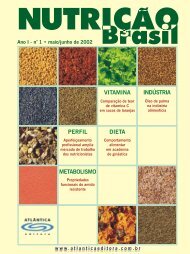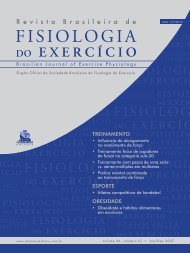Fisiologia do Exercicio_2005.pdf - Jean Peres
Fisiologia do Exercicio_2005.pdf - Jean Peres
Fisiologia do Exercicio_2005.pdf - Jean Peres
Create successful ePaper yourself
Turn your PDF publications into a flip-book with our unique Google optimized e-Paper software.
Revista Brasileira de <strong>Fisiologia</strong> <strong>do</strong> Exercício - Volume 4 Número 1 - janeiro/dezembro 2005<br />
de movimento. Adicionalmente, Nelson et al.[13] submeteram<br />
32 indivíduos, 16 homens e 16 mulheres, a 10 semanas<br />
de treinamento composto por 15 alongamentos estáticos,<br />
incluin<strong>do</strong> os principais músculos <strong>do</strong>s membros inferiores<br />
avalia<strong>do</strong>s por Gleim et al. [10]. Os autores verifi caram que<br />
embora os indivíduos alonga<strong>do</strong>s tenham aumentan<strong>do</strong> o seu<br />
desempenho no teste de sentar e alcançar, não houve prejuízo<br />
na economia de corrida [13].<br />
Conclusão<br />
É possível que as relações entre os aspectos neuromusculares<br />
como a fl exibilidade e as respostas metabólicas como a<br />
economia de movimento e o acúmulo de lactato sangüíneo<br />
não sejam tão simples quanto poderia se pensar. Existem<br />
evidências de que o aumento na amplitude de movimento<br />
articular através <strong>do</strong>s exercícios de alongamento ocorrem por<br />
uma maior tolerância ao estiramento por parte <strong>do</strong> sujeito,<br />
e não por mudanças nas propriedades mecânicas ou viscoelásticas<br />
da unidade músculo-tendão [24,25]. Neste senti<strong>do</strong>,<br />
estu<strong>do</strong>s recentes utilizan<strong>do</strong> a ultra-sonografi a para avaliar as<br />
propriedades mecânicas <strong>do</strong> tendão humano in vivo demonstraram<br />
que o treinamento de fl exibilidade afeta a viscosidade<br />
<strong>do</strong> tendão, mas não a sua elasticidade [26].<br />
Com base no que foi exposto anteriormente, concluímos<br />
que o acúmulo de lactato sangüíneo, após uma luta de Boxe<br />
Chinês, é inversamente proporcional ao nível de fl exibilidade<br />
medi<strong>do</strong> pelo teste de sentar e alcançar. O entendimento desta<br />
curiosa relação parece requisitar novos estu<strong>do</strong>s com amostras<br />
maiores e preferencialmente envolven<strong>do</strong> a avaliação da arquitetura<br />
músculo-tendínea in vivo, a qual sabidamente afeta as<br />
propriedades mecânicas <strong>do</strong> músculo esquelético [27] e podem<br />
explicar, como no caso da relação força-velocidade, muitos<br />
aspectos relaciona<strong>do</strong>s com o custo energético e a efi ciência<br />
de um movimento [28].<br />
Referências<br />
1. Zetaruk MN, Violan MA, Zurakowski D, Micheli LJ. Injuries<br />
in martial arts: a comparison of fi ve styles. Br J Sports Med<br />
2005;39:29-33.<br />
2. Kochhar T, Back DL, Mann B, Skinner J. Risk of cervical injuries<br />
in mixed martial arts. Br J Sports Med 2005;39:444-447.<br />
3. Brudnak MA, Dundero D, Van Hecke FM. Are the ‘hard’ martial<br />
arts, such as the Korean martial art, TaeKwon-Do, of benefi t<br />
to senior citizens? Medical Hypotheses 2002;59:485-491.<br />
4. Violan MA, Small EW, Zetaruk MN, Micheli LJ. Th e eff ect of<br />
karate training on fl exibility, muscle strength, and balance in<br />
8-to 13-year-old boys. Pediatric Exerc Sci 1997; 9:55-64.<br />
5. Sekulic D, Krstulovic S, Katic R, Ostojic L. Ju<strong>do</strong> training is<br />
more eff ective for fi tness development than recreational sports<br />
for 7-year-old boys. Pediatric Exerc Sci 2006;18:329-338.<br />
6. Pollock ML, Gaesser GA, Butcher JD, Despres JP, Dishman RK,<br />
Franklin BA, et al. Th e recommended quantity and quality of<br />
exercise for developing and maintaining cardiorespiratory and<br />
muscular fi tness, and fl exibility in healthy adults. Med Sci Sports<br />
Exerc 1998;30:975-991.<br />
31<br />
7. Wilson GJ, Elliott BC, Wood GA. Stretch shorten cycle performance<br />
enhancement through fl exibility training. Med Sci<br />
Sports Exerc 1992;24:116-123.<br />
8. Worrell TW, Smith TL, Winegardner J. Eff ect of hamstring<br />
stretching on hamstring muscle performance. J Orthop Sports<br />
Phys Th er 1994;20:154-159.<br />
9. Craib MW, Mitchell VA, Fields KB, Cooper TR, Hopewell R,<br />
Morgan DW. Th e association between fl exibility and running<br />
economy in sub-elite male distance runners. Med Sci Sports<br />
Exerc 1996;28:737-743.<br />
10. Gleim GW, Stachenfeld NS, Nicholas JA. Th e infl uence of<br />
fl exibility on the economy of walking and jogging. J Orthop<br />
Res 1990;8:814.<br />
11. Jones AM. Running economy is negatively related to sit-and-reach<br />
test performance in international-standard distance runners.<br />
Inter J Sports Med 2002;23:40-43.<br />
12. Beau<strong>do</strong>in CM, Blum JW. Flexibility and running economy<br />
in female collegiate track athletes. J Sports Med Phys Fit<br />
2005;45:295-300.<br />
13. Nelson AG, Kokkonen J, Eldredge C, Cornwell A, Glickman-<br />
Weiss E. Chronic stretching and running economy. Sca J Med<br />
Sci Sports 2001;11:260-265.<br />
14. Conley DL, Krahenbuhl GS. Running economy and distance<br />
running performance of highly trained athletes. Med Sci Sports<br />
Exerc 1980;12:357-60.<br />
15. Daniels JT. A physiologist’s view of running economy. Med Sci<br />
Sports Exerc 1985;17:332-8.<br />
16. Bailey SP, Pate RR. Feasibility of improving running economy.<br />
Sports Med 1991;12:228-36.<br />
17. Williams KR, Cavanagh PR. Relationship between distance<br />
running mechanics, running economy, and performance. J Appl<br />
Physiol 1987;63:1236-45.<br />
18. Jones AM, Carter H. Th e eff ect of endurance training on parameters<br />
of aerobic fi tness. Sports Med 2000;29:373-86.<br />
19. Ribeiro JL, Castro BO, Rosa CS, Baptista RR, Oliveira AR. Heart<br />
rate and blood lactate responses to Changquan and Daoshu<br />
Forms of Modern Wushu. J Sports Sci Med 2006; CSSI:1-4.<br />
20. Heck H, Mader A, Hess G, Mucke S, Muller R, Hollmann W.<br />
Justifi cation of the 4-mmol/l lactate threshold. Inter J Sports<br />
Med 1985;6:117-30.<br />
21. Forsyth JJ, Farrally MR. A comparison of lactate concentration<br />
in plasma collected from the toe, ear, and fi ngertip after a simulated<br />
rowing exercise. Br J Sports Med 2000;34:35-38.<br />
22. Saltin B, Astrand PO. Maximal oxygen uptake in athletes. J<br />
Appl Physiol 1967;23:353.<br />
23. Wasserman K, Whipp BJ, Koyal SN, Beaver WL. Anaerobic<br />
threshold and respiratory gas exchange during exercise. J Appl<br />
Physiol 1973;35:236.<br />
24. Magnusson SP, Aagard P, Simonsen E, Bojsen-Møller F. A<br />
biomechanical evaluation of cyclic and static stretch in human<br />
skeletal muscle. Inter J Sports Med 1998;19:310.<br />
25. Magnusson SP, Simonsen EB, Aagaard P, Soørensen H, Kjær M.<br />
A mechanism for altered fl exibility in human skeletal muscle. J<br />
Physiol 1996;497:291.<br />
26. Kubo K, Kanehisa H, Fukunaga T. Eff ect of stretching training<br />
on the viscoelastic properties of human ten<strong>do</strong>n structures in<br />
vivo. J Appl Physiol 2002;92:595.<br />
27. Lieber RL, Friden J. Clinical signifi cance of skeletal muscle<br />
architecture. Clin Orthop Relat Res 2001;383:140-51.<br />
28. Kohler G, Boutellier U. Th e generalized force - Velocity relationship<br />
explains why the preferred pedaling rate of cyclists exceeds<br />
the most effi cient one. Eur J Appl Physiol 2005; 94:188.





